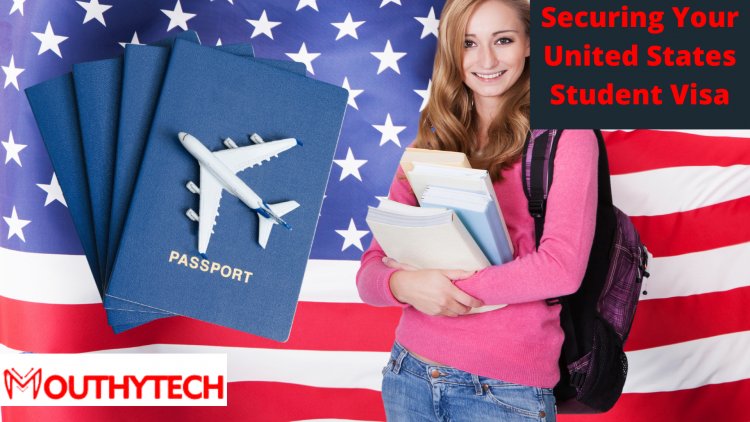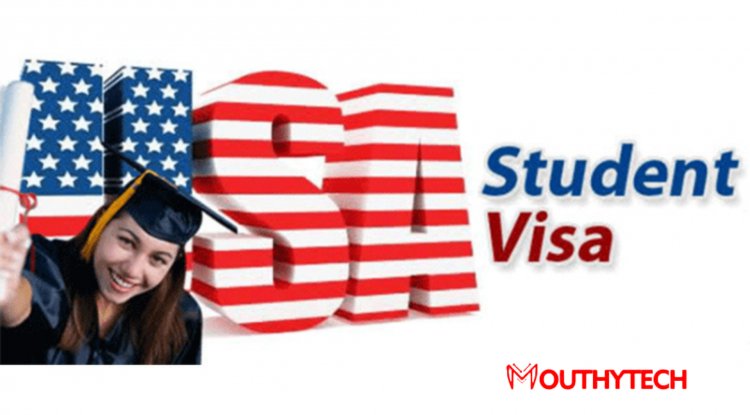Successfully Securing Your United States Student Visa
A visa is an official document that allows its holder to enter a foreign country legally. The visa is typically stamped or adhered to the bearer's passport. There are several types of visas, each of which grants the bearer unique rights in the host country. A student visa is a nonimmigrant visa that allows the holder to attend a postsecondary educational institution in the host country. Foreign exchange students in high school must typically obtain a visa for temporary residence.

A visa is a type of travel document that allows you to enter a foreign country for a limited time. Before traveling, you must usually apply for a visa, either at an embassy, consulate, or online. A visa on arrival is sometimes available. Visas are typically attached to your passport and specify the length of your stay.
Most countries require visas for foreign nationals as a security precaution: to keep track of who enters and to prevent illegal immigration. Visas are also used defensively to prevent security risks from entering a country.
Concerning Visa
A visa is a conditional authorization granted by a government to a foreigner that allows them to enter the country. Continue to be inside or leave its domain. Visas typically include time limits for the foreigner's stay. They can enter locations within the United States of America and dates. The character's ability to work in the United States or the number of authorized visits.
Visas are associated with the request for permission to enter a territory and are thus, in most countries, distinct from actual formal permission for an alien to enter and remain in the country. In each case, a visa is used to gain entry permission from an immigration official at the time of entry and can be revoked at any time.
Visa proof is typically in the form of a decal advocated within the applicant's passport or another travel document, but it can also exist electronically. Some countries no longer require physical visa evidence, preferring to record information in immigration databases.
Immigration officials have been given more authority.
Traditionally, immigration officials have had the authority to allow or deny visitors entry at the border. If the entry is authorized, the professional may issue a visa, which is a stamp in a passport that is required. Vacationers who want to visit another country must now apply in advance for what is also known as a visa, which can be done in person at a consular office, by mail, or online.
The modern-day visa could be a sticker or stamp inside the passport, an electronic record of the authorization, or a separate report that the applicant can print before entering and bring with them when they visit the visited country. For short visits, some countries no longer require visitors to apply for a visa in advance.
Requests for visas
Visa applications submitted prior to arrival give countries the opportunity to recall the applicant's circumstances, which include financial security, the reason for travel, and information about previous visits to the United States. Visitors to the site may also be required to go through and skip security or health screenings upon arrival at the port of entry.
Some emigration regulations require people to have an exit visa in order to leave the country. Depending on the guidelines of the polity in question, exit visas may be required for citizens, foreigners, or both. In contrast to regular visas, exit visas are frequently viewed as an illegitimate imposition on people's freedom of movement. The imposition of an exit visa requirement appears to be a violation of standard international law, because the right to leave any country is provided for in the Universal Declaration of Human Rights.
Svalbard, Norway's special territory, is a completely visa-free quarter under the terms of the Svalbard Treaty. Some countries, including those in the Schengen area, have agreements with other countries that allow their residents to travel freely between them. The tourism industry announced that the variety of tourists requiring a visa before traveling became at its lowest level ever in 2015.
Securing Your Student Visa to the United States
Despite recent contentious visa regulations, the United States remains one of the world's top international student destinations. The appeal of the United States to international university students is its large variety of watching programs and universities, top-ranked levels, well-equipped laboratories, generous Ph.D. funding, and the opportunity to recognize cultures from all over the world.
If you want to visit America but aren't a US citizen, you'll need to obtain a scholar visa. Obtaining a US student visa can be a lengthy process, so start planning ahead of time - at least three to five months before your course begins. There are usually several steps involved in applying for a US scholar visa. Because the procedures differ at each US embassy or consulate, it is critical to consult the instructions on the internet site of the embassy or consulate where you intend to apply.
In light of recent American immigration guidelines and the Coronavirus global disaster, visa rules have changed. They may be more complicated, but this should not deter you from pursuing your dream of studying abroad. So, here are the first steps you must take to obtain your United States scholar visa:
1) Apply to a university and get your acceptance letter
In case you're still no longer certain wherein you want to look at within the U.S., you may have to decide before you can practice for the pupil visa. you'll want an attractiveness letter (I-20 form) from the college to start your visa application method. some American universities may additionally provide you help and advice with the visa utility technique so don't hesitate to come to them with your questions.
Consider some top universities in the U.S:
- Northeastern University
- University of San Francisco
- University of California, Riverside
- Wichita State University
- American University Washington DC
- Bay Path University
2) Find out what type of student visa you need
There are three different student visas that could be an issue for international students coming to the U.S.:
- F-1 Visa - issued to students who are attending an academic program or English Language Program, valid until the completion of your study program
- J1- Visa - for exchange students
- M-1 Visa – for students who plan to attend a non-academic (technical) or vocational school, excluding language schools.
We can be concentrating on the F1 Visa, as that is the maximum not unusual take a look at visa for international college students who want to take a look at for a full-time diploma within the U.S. all of us who isn't always U.S. citizen will need an F1 scholar Visa to attend a university or university within the States.
- Gather your visa documents and start your application
First, you will have to find the embassy or consulate affiliated with your country or region where to submit your visa application. Although the process may vary or require additional steps, depending on your country and embassy or consulate, you will need the following when applying for your student visa:
- Certificate of Eligibility for Non-immigrant (F-1) Student Status (Form I-20), received from your university after you pay the SEVIS fee: 350 USD.
- Receipt of paid application fee of 160 USD for the U.S. Embassy in your country.
- Submit Online Form DS-160 for a non-immigrant visa, and bring it to your interview.
- Passport with a validity date at least six months beyond your intended period of stay in the United States.
- Any old passports.
- Documents that prove your financial situation (bank statement), or financial support during your studies.
- Standardized recent digital color photo.
- Transcripts, diplomas, degrees, or certificates from schools you attended, and any standardized test scores.
4) Wait for your visa confirmation
Student (F and M) visas for new students can be issued up to 120 days in advance of the start date for a course of study.
The time it takes to get ready for your visa appointment varies greatly between countries. Depending on the circumstances, you could have it in three days or three months. Waiting times are made even more difficult by the COVID-19 crisis. As a result, make sure to check the average visa appointment waiting times for the embassy or consulate in your area. In most cases, U.S. visas must still be issued to students who need to study in the United States despite the COVID disaster. Simply check to make certain before you begin planning.
5) Make sure you know the advantages and restrictions of your visa
- The scholar visa is usually valid for the period of your studies. However, in some cases, it's feasible you will have to apply for a visa renewal during your studies. So make sure to inspect if you come from a country that demands a visa renewal during your studies.
- F1-visa students may only get part-time employment on-campus (fewer than 20 hours per week). But work regulations for students in the U.S. are rather strict and complicated, so you may want to make sure you have enough funds so you won't need to work for the duration of your studies in the United States. Find out more about getting a job in the U.S.
- You will be allowed to arrive in the U.S. 30 days before the start of your classes.
- To keep your student visa you need to remain enrolled and maintain passing grades at your university. If you are unable to complete your program in the previously set time, your international adviser can help you request a program extension.
- If your passport expires, your country’s consulate or embassy can help you extend it.
6) Pay the SEVIS fee
You must submit the SEVIS rate at least three days before submitting an application for a US visa. You must file a web or paper form if you intend to pay the penalty. Both are accessible via the US Immigration and Customs Enforcement (ICE) SEVP website. Make sure to enter the information exactly as it appears on your I-20 or DS-2019 form.
The I-901 fee is $200 for F/M visa holders and $180 for J scholar visa holders at the time of writing. J visa holders working as camp counselors, au pairs, or in summer paintings/travel pay $35 instead. The website explains the procedure for specific types of prices as well as debit. Or use a credit card, check, international money order, or Western Union Quick Pay. After you've paid the fee, you can return to the website to check your fee reputation if you want. A third party (which includes your sponsor) can also pay the fee on your behalf. If the fee is paid on your behalf, you must keep a receipt from that 0.33 birthday party.
After processing your payment, you can obtain and print a payment confirmation from the website at any time. This confirmation will be required as proof of rate fee at your US scholar visa interview. You may also be required to show the confirmation to the customs officer at your preferred US border crossing. If you intend to convert your non-immigrant status or apply for additional US immigration benefits.
7) Complete a US student visa application
After receiving your SEVIS form and paying the SEVIS fee, you can schedule an appointment with a US consulate or embassy in your country to apply for a US student visa. Because visa processing times can vary, it's best to apply as soon as possible, regardless of when your program is set to begin. Your visa can be issued up to 120 days before your scheduled arrival in the United States.
Most countries have their own dedicated website for everything to do with making a US student visa application, which can be accessed from this main page. If you cannot find your country on the list, you may still be able to find the US embassy or consulate in your country using the US embassy’s website.
Online visa application: DS-160
You must complete the web visa application form DS-160 in all aspects. You should choose the region from which you want to apply. Also, make certain that you have all of the necessary documents. And any information you want to enter into the utility. After making a decision. After answering a security question, you'll be taken to the form's pages. You'll discover your software program id at the pinnacle. You'll need this id to retrieve your form if you want to exit the software program and return to it later.
As soon as the visa application form is completed. You must electronically signal your DS-160 by selecting the "signal application" button at the bottom. After your software has been uploaded. You will be sent a confirmation web page with a barcode and barcode quantity. And your software program identification number, which you should print out and bring with you to your visa interview. You don't want to print the entire program.
8) Pay the visa application fee
The visa application fee is also called the Machine Readable Visa Fee, or ‘MRV fee. Make sure to review the fee payment instructions available on your embassy or consulate website as methods may vary. In general, however, there are three ways to pay the non-refundable, non-transferable visa application fee:
- In-person at an approved bank
- By phone (you’ll receive a fee confirmation number)
- Online (you’ll need to print your receipt)
During your research, don’t worry if you come across the term ‘visa issuance fee based on reciprocity’ – this does not apply for F1, F2, M1, M2, J1, and J2 visa applicants. You’ll be ask for the MRV fee receipt when you get to your visa interview appointment. Some J visa applicants will not need to pay application processing fees if participating in a US Agency for International Development (USAID) program or a federally funded educational and cultural exchange program with a program serial number beginning G-1, G-2, G-3, or G-7.
About The United States
The United States of America is a country in North America that is the world's most powerful economic and military power. Similarly, its cultural imprint is felt worldwide, thanks in large part to popular culture expressed through music, movies, and television.
The country is dealing with the COVID-19 pandemic and the resulting severe economic downturn. And, following the death of Black American George Floyd at the hands of police in May 2020, calls for greater social justice resurfaced in the country. Similar movements have sprung up around the world in response to public demands to address racial inequality in institutions such as the criminal justice system and health care.
In November 2020, voters elected Joe Biden as the country's 46th president, ousting Donald Trump after one term. The country is grappling with deeply polarized politics in 2021. The deadly attack on the United States on January 6, The rejection of the November 2020 election result by Trump supporters at the Capitol underscores concerns about the health and future of American democracy.
The United States is a federal union of 50 states.
The United States is a 50-state federal union. Its political system is based on the 1787 Constitution. The US constitution incorporated Enlightenment ideas such as liberty, progress, toleration, fraternity, constitutional government, and separation of church and state. The separation of powers between the three branches of government guaranteed by the constitution ensures political control of the government. The separation of powers, also known as checks and balances, was established to ensure that no government branch has excessive power.
The United States is a federal constitutional republic made up of 50 states, one federal district (Washington DC), one incorporated territory (Palmyra Atoll), and several inhabited and uninhabited territories. The President of the United States is the Head of State and the Head of Government.
The president is regarded as the political system's focal point; he is both the head of state and government. The US Congress is the country's bicameral legislature, consisting of two chambers, the US Senate (the upper house) and the US House of Representatives (the lower house). Each state sends two senators to the Senate, regardless of population. Since the American Civil War, the Democratic Party and the Republican Party have been the most powerful actors in American politics.
Bottom-line
This is the deadline for leaving the United States. Even if your visa expires during your stay, you may remain in the United States until this date. If you leave the US with an expired visa, you will need to obtain a new one before returning to resume your studies. A student visa cannot be renewed or reissued in the United States; it must be obtained from a US embassy or consulate abroad.
However, if there is anything you believe we have overlooked, please let us know. Please keep us updated by leaving your suggestions in the comments section.
In any case, please let us know by leaving a comment below!
I hope this was useful.
Yes or No ...?
What's Your Reaction?




















